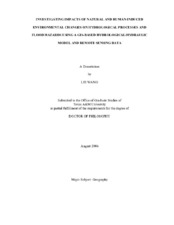| dc.contributor.advisor | Liu, Hongxing | |
| dc.creator | Wang, Lei | |
| dc.date.accessioned | 2010-01-15T00:16:29Z | |
| dc.date.accessioned | 2010-01-16T02:10:58Z | |
| dc.date.available | 2010-01-15T00:16:29Z | |
| dc.date.available | 2010-01-16T02:10:58Z | |
| dc.date.created | 2006-08 | |
| dc.date.issued | 2009-06-02 | |
| dc.identifier.uri | https://hdl.handle.net/1969.1/ETD-TAMU-1793 | |
| dc.description.abstract | Natural and human-induced environmental changes have been altering the earth's
surface and hydrological processes, and thus directly contribute to the severity of flood
hazards. To understand these changes and their impacts, this research developed a GISbased
hydrological and hydraulic modeling system, which incorporates state-of-the-art
remote sensing data to simulate flood under various scenarios. The conceptual
framework and technical issues of incorporating multi-scale remote sensing data have
been addressed.
This research develops an object-oriented hydrological modeling framework.
Compared with traditional lumped or cell-based distributed hydrological modeling
frameworks, the object-oriented framework allows basic spatial hydrologic units to have
various size and irregular shape. This framework is capable of assimilating various GIS
and remotely-sensed data with different spatial resolutions. It ensures the computational
efficiency, while preserving sufficient spatial details of input data and model outputs. Sensitivity analysis and comparison of high resolution LIDAR DEM with traditional
USGS 30m resolution DEM suggests that the use of LIDAR DEMs can greatly reduce
uncertainty in calibration of flow parameters in the hydrologic model and hence increase
the reliability of modeling results. In addition, subtle topographic features and
hydrologic objects like surface depressions and detention basins can be extracted from
the high resolution LiDAR DEMs. An innovative algorithm has been developed to
efficiently delineate surface depressions and detention basins from LiDAR DEMs.
Using a time series of Landsat images, a retrospective analysis of surface
imperviousness has been conducted to assess the hydrologic impact of urbanization. The
analysis reveals that with rapid urbanization the impervious surface has been increased
from 10.1% to 38.4% for the case study area during 1974 - 2002. As a result, the peak
flow for a 100-year flood event has increased by 20% and the floodplain extent has
expanded by about 21.6%. The quantitative analysis suggests that the large regional
detentions basins have effectively offset the adverse effect of increased impervious
surface during the urbanization process. Based on the simulation and scenario analyses
of land subsidence and potential climate changes, some planning measures and policy
implications have been derived for guiding smart urban growth and sustainable resource
development and management to minimize flood hazards. | en |
| dc.format.medium | electronic | en |
| dc.format.mimetype | application/pdf | |
| dc.language.iso | en_US | |
| dc.subject | GIS | en |
| dc.subject | Object-oriented hydrologic model | en |
| dc.subject | Remote Sensing | en |
| dc.subject | Environmental changes | en |
| dc.subject | Flood hazards | en |
| dc.title | Investigating impacts of natural and human-induced environmental changes on hydrological processes and flood hazards using a GIS-based hydrological/hydraulic model and remote sensing data | en |
| dc.type | Book | en |
| dc.type | Thesis | en |
| thesis.degree.department | Geography | en |
| thesis.degree.discipline | Geography | en |
| thesis.degree.grantor | Texas A&M University | en |
| thesis.degree.name | Doctor of Philosophy | en |
| thesis.degree.level | Doctoral | en |
| dc.contributor.committeeMember | Klein, Andrew G. | |
| dc.contributor.committeeMember | Olivera, Francisco | |
| dc.contributor.committeeMember | Sui, Daniel Z. | |
| dc.type.genre | Electronic Dissertation | en |
| dc.type.material | text | en |
| dc.format.digitalOrigin | born digital | en |


